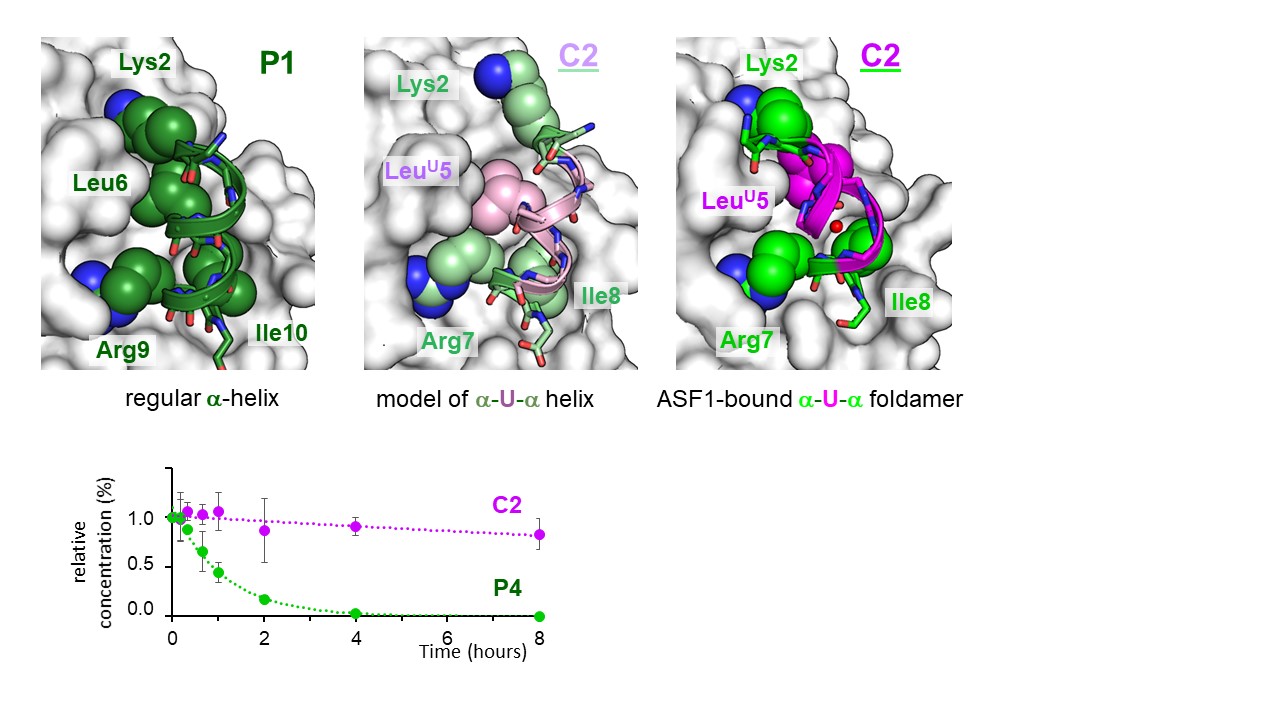From structural biology to the development of anti-cancer drugs
For about 20 years, the "Molecular Assemblies and Genome Integrity" team (CEA-Joliot/I2BC) has been studying the ASF1 protein. This 'histone chaperone', first identified as being involved in the cellular response to ionising radiation, plays a key role in the maintenance of epigenetic information during cell division. It is overexpressed in several cancer cell lines and its depletion severely compromises cell proliferation, making the protein a potential target for anti-cancer treatments. Since their initial work on the structure of the protein and its dynamic interaction with the histone dimer H3-H4, the CEA team is now trying to open up a new therapeutic avenue for certain cancers, in particular very aggressive breast cancers. Their strategy is based on the design of peptides that will associate with ASF1, instead of histones, in a sufficiently selective and specific manner to prevent ASF1 from intervening in its pathological cellular functions.
In a pilot study based on a rational strategy combining structural, computational and biochemical approaches, the team created a peptide (ip4) that inhibits the ASF1-H3-H4 dimer interaction with an affinity for ASF1 of the order of nM (Cell Chem Biol, 2019). In this study, the researchers showed in vivo that ip4 has a potential inhibitory effect on tumour growth. This work validated the relevance of ASF1 targeting and the strategy for designing ASF1 inhibitors.
Mimicking natural molecular folding with synthetic oligomers
The first peptides, including ip4, were too sensitive to proteolysis to be used as such in therapy, so the researchers went one step further by attempting to synthesise new peptides with a structure very close to the first ones, using synthesis bricks making them more resistant to proteolysis. Studies have shown that artificial polymers, foldamers, can reproduce well-defined structures of living molecules (proteins, nucleic acids, etc.) and in particular that they can be used to replace part of a therapeutic peptide without modifying its activity. In a new study published in Science Advances, the team joined forces with chemists from the European Institute of Chemistry and Biology (CNRS/Université Bordeaux - Guichard Research Lab) to design ASF1 inhibiting foldamers. As part of the polypeptide chain of the inhibiting peptides is regularly wound around itself (known as an alpha helix structure), the chemists chose to use oligoureas, known to mimic alpha helices. This is how the researchers designed a hybrid foldamer/peptide molecule, an ASF1 inhibitor. The resistance to proteolysis in human plasma is far superior to that of the related α-helical peptide. The insertion of 4 urea bricks in the centre of the helix is sufficient to protect the chimeric peptide from proteolysis. The crystal structure of the chimeric peptide/ASF1 complex reveals a remarkable plasticity of the urea backbone that adapts to the ASF1 surface and maintains the same binding interface as a non-chimeric inhibitory peptide. The affinity for ASF1 and the bioavailability of these new compounds still need to be optimised for effective ASF1 inhibition in cells.

Crystal structure of chimera C2 in complex with ASF1 compared to the binding mode of P1.
Top pannel: ASF1 bound to P1, modeled C2 and C2 in the crystal structure are depicted on the left, middle and right panels, respectively. ASF1 is displayed as a gray surface, peptides and chimera backbones as sticks. P1 is par of the alpha-helix of ip4 found in a previous study.
Bottom pannel: Stability against protease degradation in human plasma. Stability against protease degradation in human plasma. The percentage of peptide P4 or chimera C2 detected by LCMS is reported as a function of time. Error bars represent standard deviation from three independent experiments.
Researcher Contact:
Françoise Ochsenbein (francoise.ochsenbein@cea.fr)
[1] Determination by liquid chromatography-mass spectrometry
LEMM (SPI/DMTS, institut Joliot)